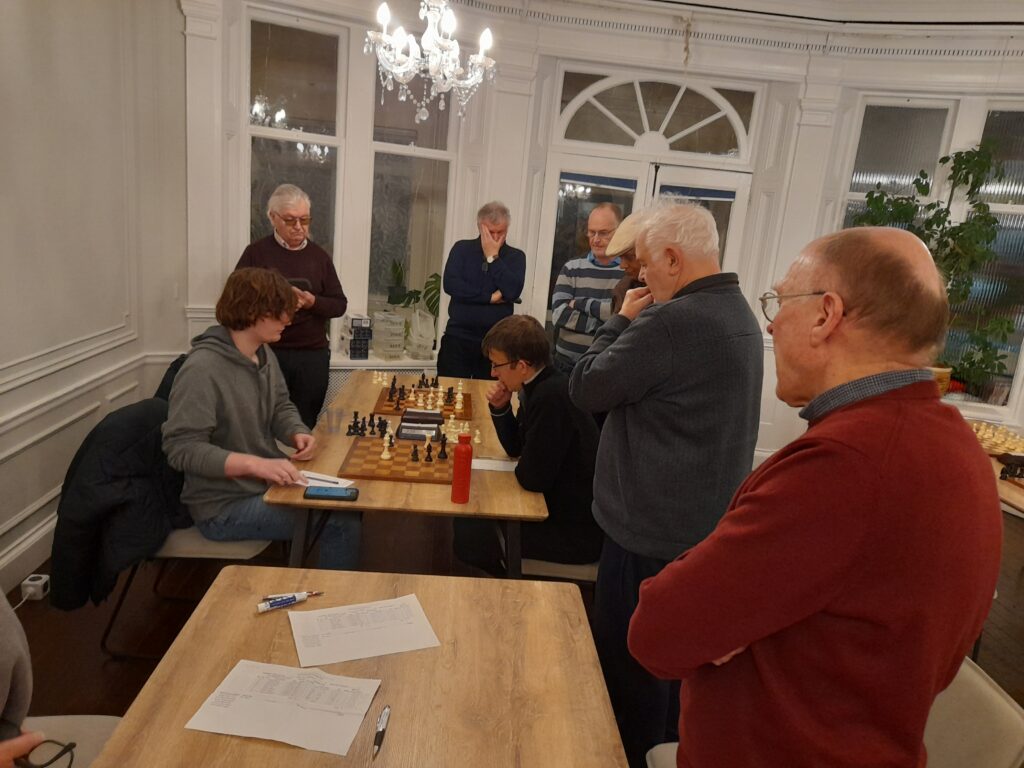Surrey League division 2 match played at Fircroft, Surbiton on 3 January 2024
For Kingston 2 to secure a draw against Surbiton 1 in the second division of the Surrey League is on paper a very good result, but there was a slight sense at the end of this invigorating New Year match that victory had slipped from our grasp, with Peter Andrews and Stephen Lovell having to settle for draws in games which at one point looked like possible wins. We should, though, not be greedy: after last year’s battles, Kingston 2 is so far doing far better in this tough division this season.
The board 7 game was first to finish with old adversaries Jon Eckert and Surbiton captain Graham Alcock, who played his customary Scandinavian, declaring peace after 20 moves. That draw set a pattern for the match, which was clearly going to be very tight.
On board 2, Altaf Chaudhry and Kingston’s Julian Way also settled for a draw. Julian blunted Altaf’s English Opening, establishing a pawn on e4. After some grandmasterly manoeuvring, the two players repeated moves and accepted the inevitability of a draw in the position shown below where 27… Bf8 forces the white queen back to c1.
John Foley, with White against Jasper Tambini on board 3, had essayed a pawn sac to get Black’s king offside and allow a pawn advance in the centre. But is proved rather speculative and thereafter Tambini, who has returned to his old club Surbiton after a short spell at Wimbledon, seized the initiative, went the exchange up and forced victory. Advantage Surbiton.
David Rowson appears destined to spend his entire season playing against Surbiton’s Liam Bayly – they also met recently in a first-team match, when Liam had the better of it, and were likely to meet again when Surbiton 2 and Kingston 2 met on 10 January. On this occasion, David had no difficulty neutralising Liam’s Giuoco Piano and may even had established a slight edge but, after an exchange of queens, another relatively bloodless draw resulted.
Alan Scrimgour always appeared to be doing well with White on board 5 against the redoubtable Nick Faulks, and so it proved. “I didn’t expect to play Nick and only discovered after the game that we have now played three c3 Sicilians with me as White,” Alan said after the game. “This explains why, presumably remembering, he played the first 12 moves quickly, leaving me well behind on the clock. The first crucial decision by me was to play the risky-looking 16. g4 followed by 17. Ne5. Although this position (see below) was roughly equal, Black was cramped and subsequently played a couple of inaccuracies, ceding the pawn on b7 with 19… Qd6, presumably hoping to use the Bb8/Qd6 diagonal.”
Alan now had a healthy plus, but missed a chance in the position below when 23. b5 would have left the black queen very short of squares and would most likely have won the exchange.
But despite missing that chance, Alan retained his advantage and won a piece with a tactical sequence half a dozen moves later. That tied the match at 2.5-2.5, but with Peter Andrews holding the upper hand against David Scott on board 1 and Stephen Lovell, on his seasonal debut and after a year-long break from league chess, material up against Joshua Pirgon on board 6 we felt we had a sniff of victory.
Peter Andrews also played an English, discovering later that his opponent David Scott played the same line as White. In the position below, Peter has just played 15. d4, which he describes as a “very committal move which opened the position enough to make it hard for either of us to keep control of all our weaknesses”.
Peter believed 24. Na4 in the position below gave him a substantial edge, which indeed it does, though he believes with support from some engines (not all interestingly) that Nd7 is even stronger:
With time starting to press for both players, could Peter find a winning plan? He was pleased, in line with his New Year resolution, to find a backward diagonal queen move to further increase the tension in the position, and reached this position after 31. Nf5, when White has a substantial advantage:
But that was as good as it got, for reasons Peter explains in his inimitable style in the annotation he did for the game: “At this point I had well under five minutes left and stopped recording. Given that the position is +5 for White – he has an extra exchange in an open position, a better pawn formation, and more active and co-ordinated pieces – the reader may ask how on earth the game ended as a draw. I am unable to reconstruct the rest of the game, which in itself is telling.
“Hereabouts, I had a mental blank. The position has changed completely from the tense struggle up to move 23. I no longer had an obvious plan, or time on the clock to formulate one; my objectives were not to blunder something catastrophic and to hope that my opponent allowed something loose to drop off, or to steer for an ending and trust that the material advantage would count. However, I made the mistake of exchanging rooks on c4, giving him a passed pawn, and then exchanging queens.
“He managed to defend the pawn, and knights are not very good at rounding up a mobile pawn. So I gave back the exchange to win the pawn, leaving me with two knights and four pawns against bishop, knight and three pawns. I then left a pawn en prise and immediately offered a draw, which was accepted, not noticing until too late that if he took the pawn my king could have forked his two minor pieces. Whether the pawn-up minor-piece ending was winnable is doubtful, with the clock pressing and all the pawns on one side, but I could no doubt have made him suffer for some time.”
An honest and illuminating assessment from a serious player who never spares himself from self-criticism. The match was now tied at 3-3 and it was all down to the roller-coaster encounter being played out on board 6 between Stephen Lovell and Joshua Pirgon.

If some of the games in this match were relatively tame, this encounter was anything but. The opening was a French Tarrasch. “I wasn’t entirely happy with how I handled the opening,” Stephen said afterwards. “Closing the position with 17 … f5 (see position below) was quite possibly a mistake, but I thought I would have to do it at some point anyway and felt I had the resources to deal with any kingside attack.”
White took up the challenge, sac-ing a piece and lining his heavy artillery up against the Black king.
White’s threats are largely illusory – Stephen was right that he did have the resources to deal with the expected kingside onslaught. But in practical club chess with time rapidly diminishing, your mind starts to play strange tricks. “After 33. Rfh2 I suddenly realised I had some calculating to do,” Stephen says, “and spent much too much time thinking before my 33rd move.”
Stephen did in fact play accurately: 33. Rxf4 34. Rxh7 Qxe5. This is surely winning, despite the rook checks that are coming for White, but his opponent played resourcefully and was able to play 37. Bxg6 with check, creating a passed g-pawn. Now it was complete mayhem and Stephen was playing on the increment. “I was in a fog of time trouble,” he says. “All of a sudden the g6 pawn had become a big factor, and I couldn’t see a clearly winning way of stopping it. Nor could I see a mate. So I decided to let the pawn queen, imagining that I should still win with a material advantage and a vulnerable white king. But something went wrong, as it so often does!”
The position was liquidated down to an endgame in which Stephen had bishop and three pawns against rook and pawn. It was knife edge and could have gone either way, but in the end a draw was agreed. What a game with which to return to competitive action after a year away. Stephen promises he will play again – in about another year’s time. That’s enough excitement for 2024.
Stephen Moss, Kingston captain in Surrey League division 2

